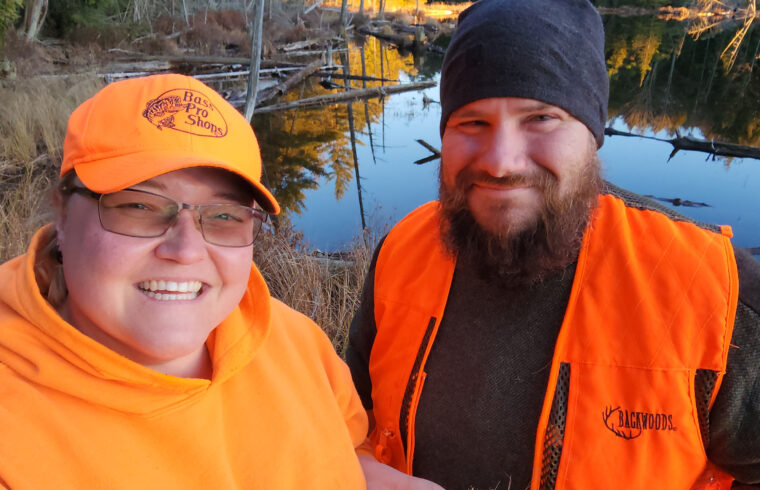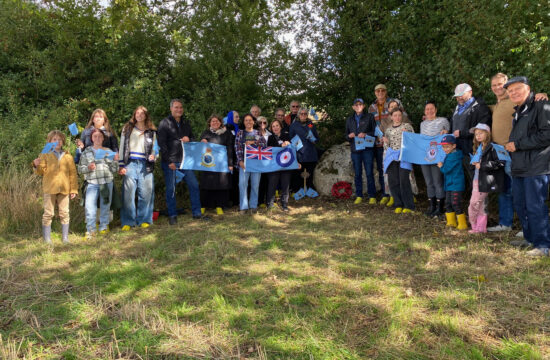By Thomas Smith
Haliburton Forest has taken a monumental step in fostering a relationship between their company and members of the Williams Treaties First Nations.
The process started six years ago, when Haliburton Forest’s General Manager Tegan Legge and Canadian Bushcraft’s Caleb Musgrave discussed ways in which the Forest could better support Indigenous communities in Ontario.
Haliburton Forest’s base camp is located at 1035 Redkenn Road in Haliburton, and their property stretches across 100,000 acres to the southern tip of Algonquin Park and Powderhorn Lake to the west.
The managing director at the time asked them what could be the quickest and easiest way for the company to work towards earning their PAIR certification (Partnership Accreditation in Indigenous Relations).
Musgrave was quick to say that growing manoomin, often called Northern wild rice, would be both the most cost effective and quickest way to begin the collaboration.
Musgrave is an Anishinaabe Knowledge Holder, storyteller, woodsman, and outdoor survival expert who has taught traditional Anishinaabe knowledge and survival skills for 18 years. Musgrave’s company, Canadian Bushcraft, is owned and operated in Hiawatha First Nation and is dedicated to teaching people about land-based tools and techniques. Teaching over 20,000 students over his career, some of the topics have included food gathering, harvesting, canoe building, and basket weaving. Musgrave is dedicated to teaching traditional ecological knowledge and archaeology. He also hosts the Canadian Bushcraft Podcast, with Caleb Musgrave, with which he discusses everything related to survival and hunting through stories and candid experiences.
This will be the second time that Musgrave has used his knowledge of manoomin to help a company in planting their own patches of wild rice.
“We’re always thinking of ways of bringing more Indigenous culture to the Forest,” said Legge. Together, the pair found four lakes that were suitable for planting manoomin. One in the northern end, two in the eastern area, and one near the main corridor of the forest.
The lakes were selected because they received little traffic and had no cottages or campsites on them; entirely separate from any other lake in Haliburton County. These landlocked lakes are privately owned, and have creeks flowing into them which provide fresh and clean water directly from the forest.
Manoomin requires specific conditions to grow, says Musgrave. The plant will not grow in water that is deeper than five feet. It also requires a silty bottom with a large amount of organic matter and will not grow in rocks or sand.
“Manoomin is a very durable plant once it is established,” he said.
It is traditionally collected by canoe using knocking sticks to free the seeds from the plant. During this process, typically a third of the rice is released back into the water. This process allows the plant to grow future generations of manoomin. As the seeds enter the water and become saturated, the rice descends to embed itself into the sediment at the bottom. With small seeds, the manoomin needs precise conditions for the plant to have enough energy to reach towards sunlight, and propagate itself before the end of the season.
Manoomin seeds must also be kept moist, or risk becoming unviable.
After collecting the manoomin on Rice Lake, the harvest is divided up to ensure that the local community has enough of it as a food source. People are also given manoomin seeds to reseed their own wild rice patches.
Using a cleaning process, no invasive species are capable of entering the water in Haliburton County, says Legge.
Planting the manoomin across the four lakes took a half a day and was conducted in November of last year.
“We went in with no expectations,” said Legge. “However, we did have our hopes.”
In July of this year, Legge was ecstatic to see manoomin floating on the top of the lakes.
When in bloom, the manoomin is stunning, with pink and yellow flowers.
“It’s like being a proud gardener,” said Legge. “I’m a proud mom watching my little plants grow.” Unfortunately, one of the lakes seeded with manoomin did not have new growth. Legge says that the section of the lake they seeded did not meet the right conditions for growth, perhaps due to the sun in their eyes after a long day of seeding.
Legge says that there are no records of manoomin growing in any of the 100 lakes across the 100,000 acres of Haliburton Forest.
However, this could very likely be due to human or environmental factors. The range of the species extends well past Haliburton into regions of Northern Ontario. It is very likely that manoomin could have grown there in the past, there is just a lack of evidence.
One of the most well known waterbodies for manoomin in Ontario is Rice Lake.
Musgrave says that in the past, Rice Lake was a prolific producer of manoomin for those harvesting in the Mississauga Anishinaabeg territory. In the 1920s, 10,000 bushels of manoomin were harvested from Rice Lake, meaning that 620,000 pounds of rice could be harvested annually.
When the Trent-Severn waterway was constructed, many of the rice beds were flooded. Pigeon Lake was born from the flooding of the Trent-Severn, converting what used to be swampy marsh land into the small lake that is known today.
There has been a lot of negativity around manoomin. Select cottagers disliked it, saying that it is invasive, reduces the price of their property, and reduces the ability to access the water.
Keep in mind that manoomin was here long before the cottages were.
Tensions are high on Rice and Pigeon Lake, with property owners accusing Anishinaabeg rice harvesters of planting seeds illegally.
In Pigeon Lake, Parks Canada has had to erect signs indicating the boundaries of a Wild Rice Protection Zone.
The destruction of manoomin is illegal. Musgrave says that during some harvests, Anishinaabeg harvesters had to be escorted and protected by the OPP.
“It was actually kind of heartwarming,” said Musgrave. “We’ve been fearful for our lives and for our safety.”
Realistically, manoomin is an indicator of a healthy and diverse ecosystem. The floating vegetation provides ample shelter for fish fry. As bigger fish hunt around the vegetation, it brings birds of prey and shorebirds that eat the fish or seeds themselves, says Musgrave.
When manoomin becomes established in Haliburton Forest, Musgrave and Legge agree that the lakes will become a special place of education for future generations.
As a privately owned space that is open to Musgrave and members of the Williams Treaties First Nations, people can visit Haliburton Forest without fear of harassment.
Legge says that Haliburton Forest will be operating a harvesting list, providing Indigenous Peoples with naturally harvested goods like birch bark, spruce roots, and other medicines.
With Haliburton Forest’s biologists monitoring water conditions, the manoomin is assured to be of a high quality.
Musgrave says that the manoomin grown in places like Rice and Pigeon Lake can easily be contaminated with runoff and heavy metals that are dangerous to human health.
In the future, Musgrave wants to bring more First Nations community members into the forest to learn how to harvest manoomin, prepare it, and use it in ceremony.
Haliburton Forest is fully supporting the opening of their land, encouraging generational knowledge, and providing a guaranteed safe harvest site.
From Haliburton Forest’s perspective, the reception to the manoomin has been terrific. Primarily, the biggest supporters have been the hunters that visit.
More vegetation on the lakes encourages more ducks to visit and nest. Some hunters have even shown an interest in growing their own manoomin.
For seasonal hunters, the manoomin will mean a better quality of meat, future generations of waterfowl, and opportunities to harvest from the land.
“Our hunters are really excited about this happening on the property,” said Legge. “They understand the environmental benefits and how it will attract more waterfowl.”
“I have yet to hear about any private forests that are working with their Indigenous communities in such a manner,” she said.
Both Legge and Musgrave consider this planting of manoomin a monumental undertaking which will inspire and inform other businesses across Canada.
“Manoomin is a crucial part to Anishinaabe identity,” said Musgrave. “I would like to thank Haliburton Forest for strengthening that relationship.”
The Canadian Bushcraft Podcast, with Caleb Musgrave is available on Apple Podcasts and Spotify.





 From left, Tegan Legge and Caleb Musgrave hold manoomin seeds before being planting them in lakes on Haliburton Forest’s property. /Submitted
From left, Tegan Legge and Caleb Musgrave hold manoomin seeds before being planting them in lakes on Haliburton Forest’s property. /Submitted 



